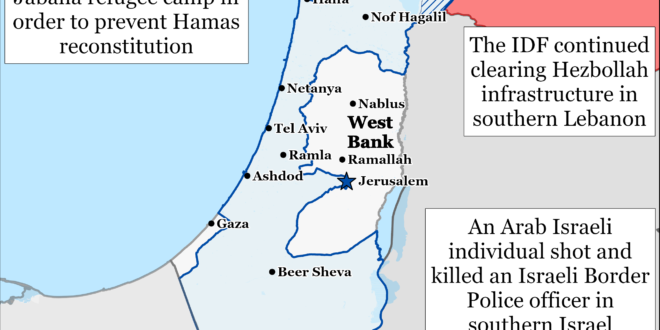Western and Middle Eastern outlets have suggested that Israel killed or injured Islamic Revolutionary Guards Corps (IRGC) Quds Force Commander Brigadier General Esmail Ghaani on October 4. Iran and Lebanese Hezbollah have been unable to contact Ghaani since Israel conducted an airstrike targeting Hashem Safi ed Din—the presumed successor to Hassan Nasrallah—in Beirut on October 4.[i] Ghaani was in Beirut at the time of the Israeli airstrike, according to the New York Times and Reuters. He was reportedly helping Hezbollah recover from recent Israeli attacks on the group.[ii] An Iranian security official told Reuters that Ghaani was not meeting with Safi ed Din when the Israeli airstrike targeted the latter. Ghaani was last seen publicly when he visited the Hezbollah representative office in Tehran on September 29.[iii] Ghaani has been notably absent from high-profile regime events since then. He was not seen at Iranian Supreme Leader Ali Khamenei’s Friday prayer sermon on October 4 or when Khamenei met with Iranian military leadership on October 6.[v]
Some Iranian officials and state-affiliated media have called on the regime to confirm whether Ghaani is alive. An Iranian parliamentarian claimed on October 6 that Ghaani is “in perfect health” and called on the IRGC to address the rumors of his death or injury in Beirut.[vi] An outlet tied to former IRGC Commander Mohsen Rezaei similarly called on the regime to publish “news that our general is alive and well.”[vii] An IRGC member stationed in Beirut told the New York Times that the regime silence about Ghaani’s status has created “panic among rank-and-file members.”[viii]
Israeli leaders have continued signaling that they will retaliate for the Iranian ballistic missile attack on Israel on October 1. Israeli Defense Minister Yoav Gallant said during a visit to the IDF Nevatim airbase that Israel will respond to Iran at an appropriate place and time and in a manner of its choosing.[ix] The Nevatim airbase was one of the sites that Iran targeted in its recent missile attack.[x] Several missiles hit the base, causing minor damages.[xi] Gallant added that the Iranian attack “didn’t even scratch” the capabilities of the IDF Air Force.[xii] Israeli President Isaac Herzog separately said that the Iranian attack “obviously deserves a response” in an interview with Saudi media.[xiii]
Israeli Defense Minister Yoav Gallant will reportedly travel to the Washington, DC, to meet with US Defense Secretary Lloyd Austin III on October 9.[xiv] Gallant and Austin are expected to discuss US-Israel security cooperation vis-a-vis Iran.[xv]
Iran appears to be preparing for an Israeli retaliation amid reports that Israel may strike sensitive Iranian sites, such as energy and nuclear infrastructure.
The Iranian State Civil Aviation Organization cancelled all civilian flights in Iran from 2100 local time on October 6 to 0600 local time on October 7.[xvi] These times equate to 1400-2300 ET on October 6.
The Iranian National Tanker Company has vacated empty oil tankers from the main Iranian oil export terminal on Kharg Island.[xvii] Many vessels that had been docked at Bandar Abbas have left as well.[xviii]
Iranian Oil Minister Mohsen Paknejad met with IRGC Navy officers in Bushehr City to discuss the security of the South Pars gas field, which is the largest Iranian gas field.[xix] Paknejad also visited Kharg Island.[xx]
The IDF continued clearing Hezbollah infrastructure around Maroun al Ras and Odaisseh in southern Lebanon. The IDF 188th Armored Brigade (36th Division) engaged Hezbollah Radwan special operations forces (SOF), killing some and destroying military headquarters and warehouses south of Bint Jbeil .[xxi] The brigade commander said that the IDF is focusing on destroying Hezbollah surface and sub-surface infrastructure in order to prevent Hezbollah attacks into Israel.[xxii] The IDF 1st Golani Brigade (36th Division) destroyed tunnel shafts and ammunition depots near Maroun al Ras.[xxiii] The IDF 35th Paratroopers Brigade (98th Division) seized ”hundreds” of weapons and a vehicle used by Hezbollah Radwan SOF.[xxiv] An anti-aircraft gun was mounted atop the vehicle, according to an Israeli military correspondent.[xxv]
Israeli forces separately located a Hezbollah Radwan SOF warehouse and weapons storage facility in a tunnel complex beneath a civilian home in Odaisseh along the Israel-Lebanon border.[xxvi]
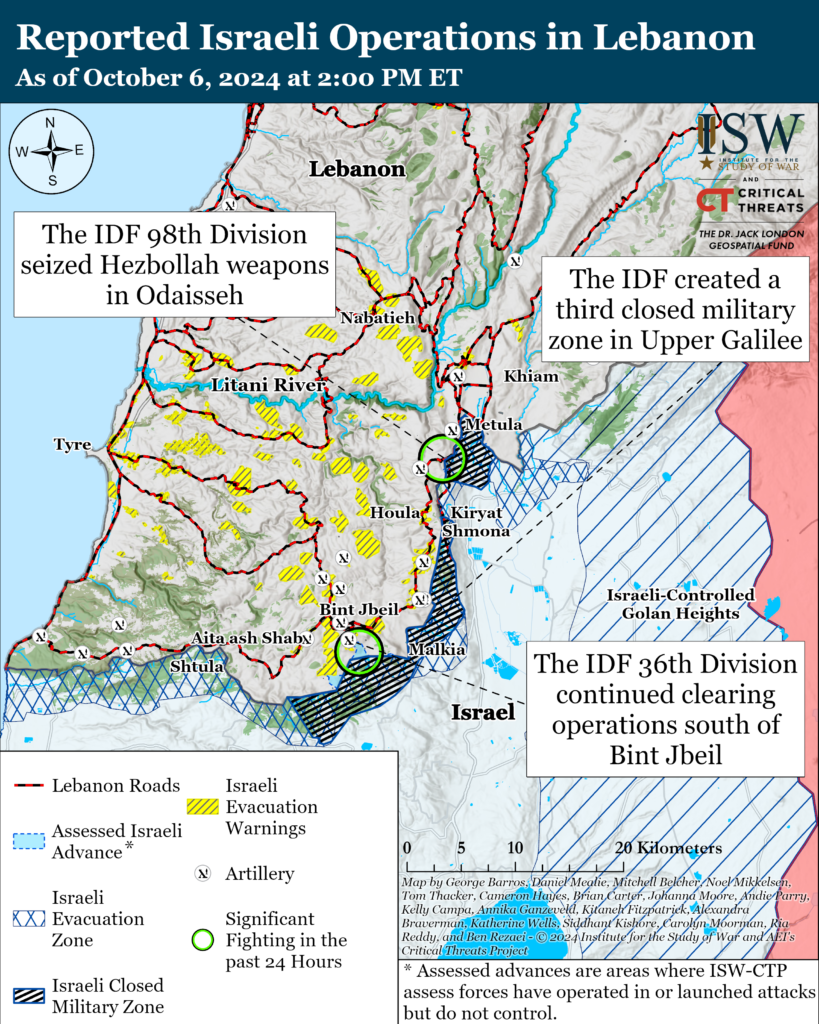
The IDF created a third closed military zone in the Upper Galilee on October 6.[xxvii] The new zone encompasses Malkia, Manara, and Yiftah, which is between the two existing closed zones. The IDF created closed military zones over the Metula area on September 30 and over the Dovev, Tzvion, and Malkia areas on October 1.[xxviii] Hezbollah claimed that Israeli forces tried to cross into Blida, which is adjacent to newly closed Yiftah on October 5.[xxix] Commercially available satellite imagery captured on October 6 indicates that Israeli forces operated near Blida. An Israeli military correspondent reported on October 4 that the IDF is preparing to expand its ground operations in southern Lebanon.[xxx]
The IDF Arabic-language spokesperson called on civilians to evacuate immediately from 25 towns and villages in southern Lebanon on October 6.[xxxi] The spokesperson told residents that they should head north of the Awali River.[xxxii]
The IDF launched a new clearing operation into Jabalia refugee camp, Gaza City, on October 6 in order to disrupt Hamas reconstitution efforts.[xxxiii] The IDF last operated in the area in May 2024, during which the IDF encountered significant resistance from three Hamas battalions.[xxxiv] Hamas has reportedly re-armed and re-organized itself in the four months since the IDF withdrew.[xxxv] An Israeli military correspondent said that the IDF assesses that there are thousands of original Hamas fighters and thousands of new but poorly trained Hamas recruits in the northern Gaza Strip.[xxxvi] The IDF stated that it would operate around Jabalia for as long as is required in order to thoroughly destroy Hamas infrastructure there.[xxxvii] The IDF Air Force struck dozens of militia sites around Jabalia as the IDF 401st and 460th armored brigades encircled the camp.[xxxviii] Israeli forces have engaged dozens of Palestinian fighters around Jabalia since entering the area.[xxxix] The 401st and 460th armored brigades are operating under the command of the 162nd Division, which had been leading operations in Rafah since May 2024.[xl] The IDF Gaza Division will now lead the Givati and Nahal brigades in clearing operations in Rafah.[xli]
Anonymous Iraqi officials claimed that the United States sent “strongly worded” messages to the Iraqi federal government following an Iranian-backed Iraqi militia attack targeting a US diplomatic facility in Baghdad.[xlii] An Iranian-backed Iraqi militia attacked the US Diplomatic Support Complex near Baghdad International Airport on October 1.[xliii] The Iraqi officials claimed that the United States threatened to attack Iranian-backed militias if they continued to attack US positions or escalated further against Israel.[xliv] The Islamic Resistance in Iraq—a coalition of Iranian-backed Iraqi militias—has increased its rate of attacks targeting Israel since September 17.[xlv]
Key Takeaways:
- Iran: Western and Middle Eastern outlets have suggested that Israel killed or injured IRGC Quds Force Commander Esmail Ghaani in an airstrike in Beirut. Iran and Lebanese Hezbollah have reportedly been unable to contact Ghaani since the airstrike.
- Iran: Israeli leaders have continued signaling that they will retaliate for the recent Iranian ballistic missile attack. Iran appears to be preparing for an imminent Israeli strike, possibly targeting Iranian energy and nuclear infrastructure.
- Lebanon: The IDF continued clearing Lebanese Hezbollah infrastructure around Maroun al Ras and Odaisseh. The IDF also created a third military zone in the Upper Galiliee, amid Israeli reports that the IDF will expand its ground operations into Lebanon.
- Gaza Strip: The IDF launched a new clearing operation into the Jabalia refugee camp in order to disrupt Hamas reconstitution efforts. The IDF last operated in the area in May 2024 and encountered significant resistance from three Hamas battalions.
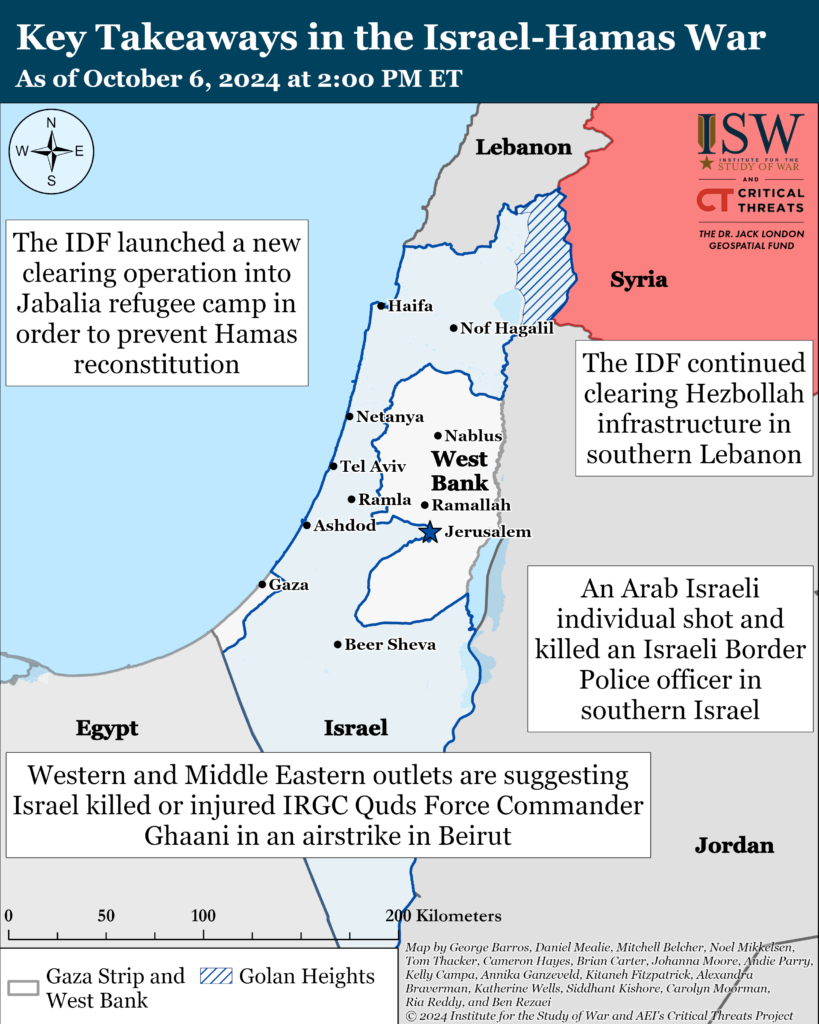
Gaza Strip
Axis of Resistance objectives:
Erode the will of the Israeli political establishment and public to sustain clearing operations in the Gaza Strip
Reestablish Hamas as the governing authority in the Gaza Strip
Five Palestinian militias, including Hamas, defended against Israeli advances into Jabalia on October 6.[xlvi] The militias conducted combined attacks using several types of weapons systems, indicating that the militias retain some ability to coordinate operations and access diverse weapons stockpiles. Hamas and Palestinian Islamic Jihad (PIJ) snipers fired on Israeli forces in and on the way to Jabalia.[xlvii] PIJ fired thermobaric rockets targeting an IDF headquarters in Jabalia refugee camp.[xlviii] The al Aqsa Martyrs’ Brigades detonated an improvised explosive device (IED) targeting an Israeli tank advancing into Jabalia camp.[xlix] PIJ and the Popular Front for the Liberation of Palestine fighters targeted Israeli armored personnel carriers with anti-tank shells.[l]
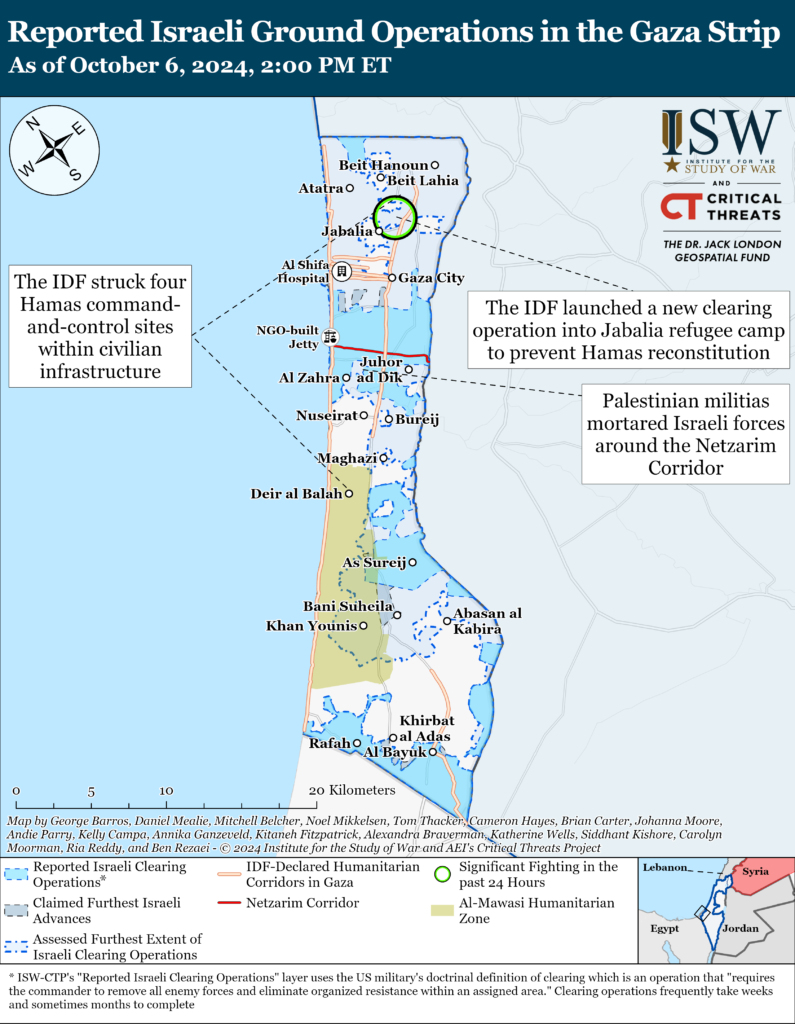
The IDF Air Force struck four Hamas command-and-control sites in the central and northern Gaza Strip on October 5 and 6.[li] The IDF struck two schools, a mosque, and an UNRWA headquarters that Hamas fighters were using to plan attacks targeting Israeli forces. The IDF stated that it took steps to minimize civilian casualties in the airstrikes.[lii] The Hamas-run Health Ministry reported that the strikes in the central Gaza Strip killed 26 people.[liii] An Israeli military correspondent said that Israeli security officials believe that Hamas is preserving its governance role in the Gaza Strip by offering services and aid from shelters, schools, and hospitals in the northern Gaza Strip.[liv] Junior Hamas field commanders reportedly direct efforts to regenerate and reorganize Hamas forces from these shelters, schools, and hospitals.[lv]
Two Palestinian militias mortared Israeli forces around the Netzarim Corridor on October 6.[lvi] The IDF 252nd Division operates along the corridor.[lvii]
The IDF expanded the al Mawasi humanitarian zone eastward into central Khan Younis City on October 6.[lviii] The IDF stated that the expanded zone includes field hospitals, tent encampments, and supplies of food, water, medicine, and medical equipment.[lix] The IDF also released a new evacuation map system for the northern Gaza Strip that groups ”blocks” into larger areas that the IDF stated that it will use to ”issue evacuation orders as necessary to wider areas.”[lx] The IDF did not issue specific evacuation orders for the northern Gaza Strip on October 6 but called the entire northern Gaza Strip a dangerous combat zone.[lxi]
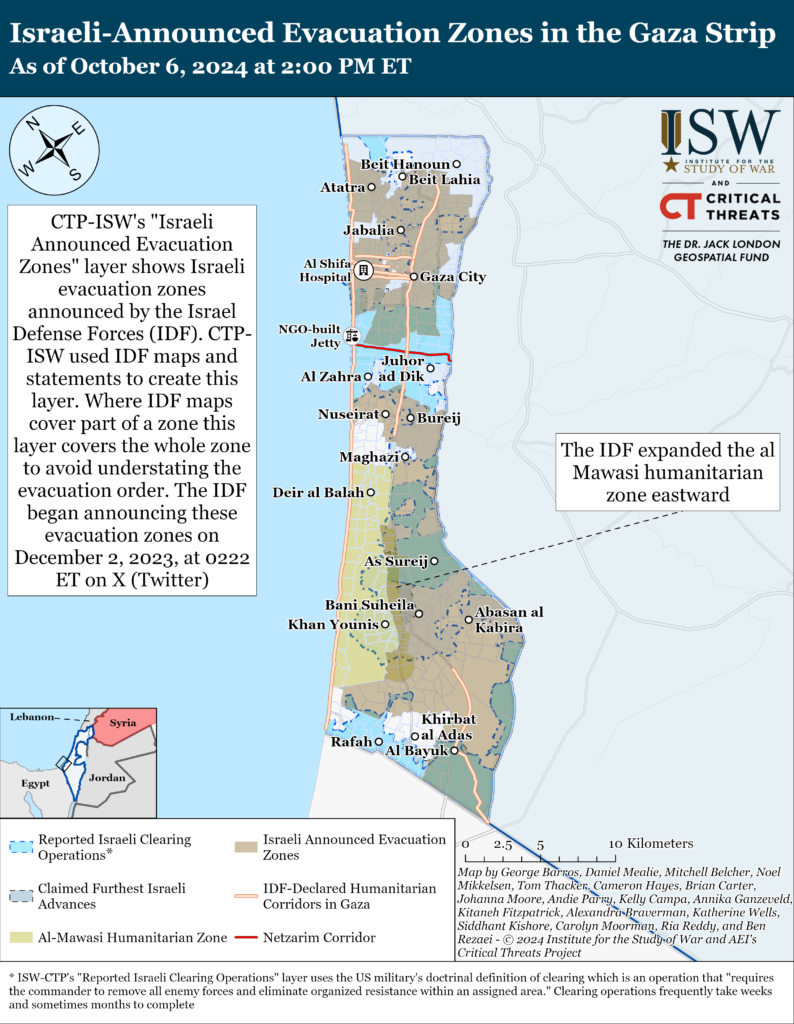
PIJ fired three rockets from the northern Gaza Strip targeting Ashkelon, southern Israel, on October 6.[lxii]
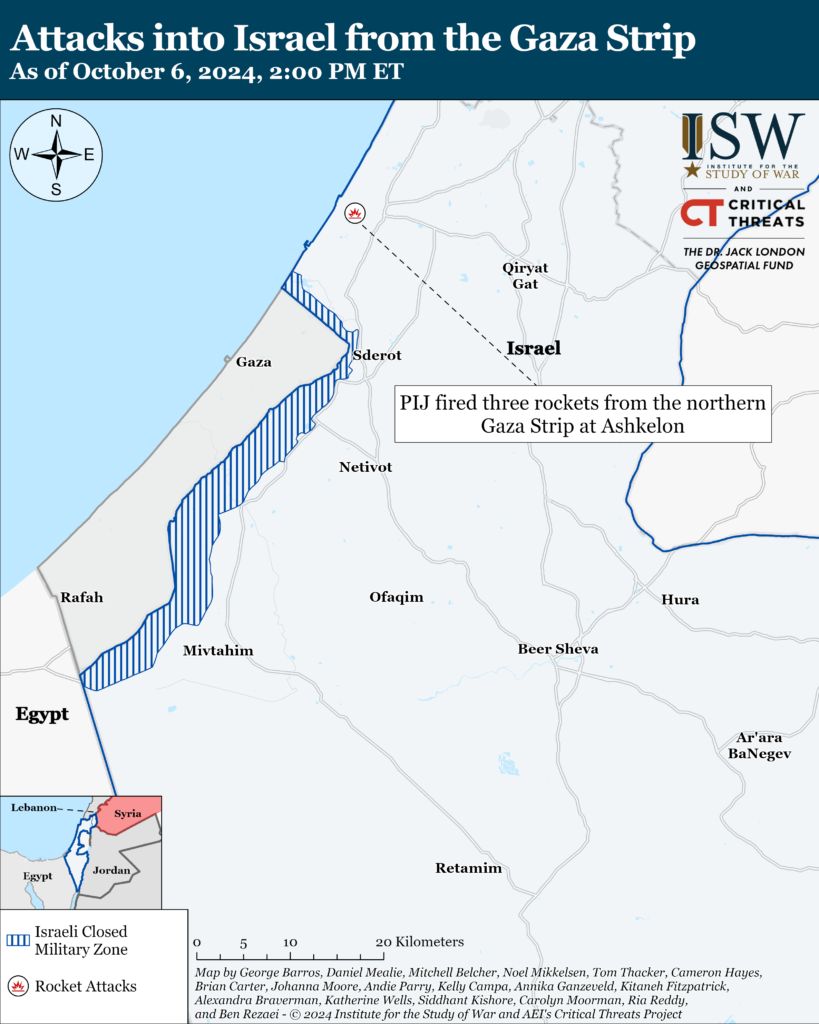
Recorded reports of attacks; CTP-ISW cannot independently verify impact.
West Bank
Axis of Resistance objectives:
Establish the West Bank as a viable front against Israel
An Arab Israeli individual shot and killed an Israeli Border Police officer in Beersheba in southern Israel on October 6.[lxiii] The gunman also wounded ten other civilians before Israeli security forces killed him.[lxiv] An Israeli Army Radio correspondent reported that the attacker was a resident of Negev and had a criminal record.[lxv] Palestinian militias praised the attack, however, no group has taken responsibility for it at the time of this writing.[lxvi]
An Israeli Army Radio correspondent revealed that Hamas fighters crossed into Israel from West Bank through a breach point in the Israel-West Bank border to conduct the shooting attack in Jaffa on October 1.[lxvii] The correspondent said that there are “hundreds” of breach points along the border and that “thousands” of Palestinians cross into Israel every day illegally without supervision.[lxviii] In September 2024, at least 1,100 Palestinians reportedly crossed into Israel illegally through these breach points, and only 190 of them were caught. Israeli security officials have pushed Israeli civil authorities to secure the Israel-West Bank border by addressing the breach points.[lxix]
Israeli forces have engaged Palestinian fighters in at least three locations in the West Bank since CTP-ISW’s last data cutoff on October 5.[lxx] The al Aqsa Martyrs’ Brigades fired small arms and detonated IEDs targeting Israeli forces in Jenin Governorate.[lxxi] The Palestinian Mujahideen Movement claimed that it fired small arms targeting Israeli civilians and security personnel in Jenin on October 6.[lxxii]

This map is not an exhaustive depiction of clashes and demonstrations in the West Bank.
Northern Israel and Lebanon
Axis of Resistance objectives:
Deter Israel from conducting a ground operation into Lebanon
Prepare for an expanded and protracted conflict with Israel in the near term
Expel the United States from Syria
Lebanese Hezbollah has conducted at least 15 attacks into northern Israel since CTP-ISW’s last data cutoff on October 5.[lxxiii] Hezbollah conducted a four-wave rocket attack targeting an IDF position in Manara.[lxxiv] Hezbollah also launched one-way attack drones targeting an IDF position and ammunition depot near Haifa.[lxxv] Hezbollah separately fired one-way attack drones targeting Israeli forces in Maalot Tarshiha.[lxxvi] Hezbollah claimed that it launched rockets targeting Israeli civilian sites in Safed.[lxxvii]
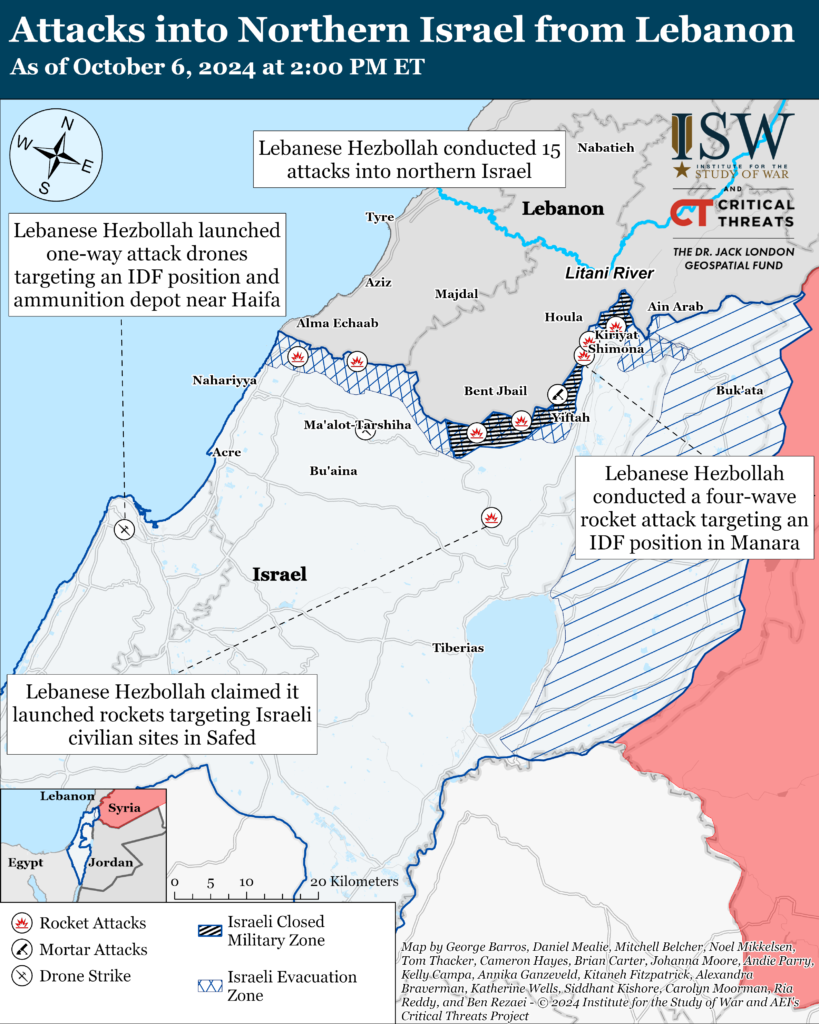
The IDF continued its air campaign targeting Hezbollah capabilities, infrastructure, and leadership. The IDF struck Hezbollah sites, including underground complexes and weapons storage facilities, in southern Lebanon on October 5 and 6.[lxxviii] The IDF also conducted an airstrike that killed a Hezbollah company commander in Kfar Kila.[lxxix] The IDF separately conducted at least 30 airstrikes targeting Hezbollah positions in Beirut.[lxxx]
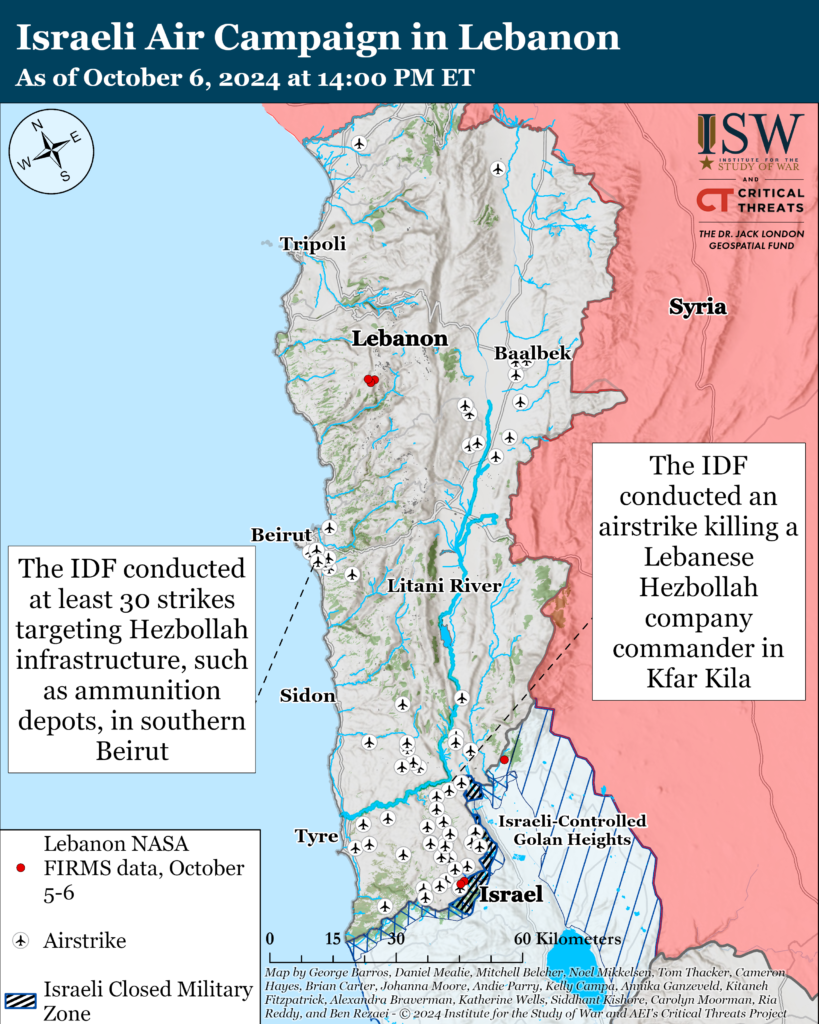
This map illustrates individual Israeli air and artillery strikes based on local Lebanese reporting. This map depicts strikes reported from 2:00pm ET on October 5 to 2:00pm ET on October 6. This map is not exhaustive. CTP-ISW cannot independently verify the locations of Israeli strikes.
Iran and the Axis of Resistance
The Islamic Resistance in Iraq claimed on October 6 that it conducted three drone attacks targeting three separate unspecified locations in the Golan Heights.[lxxxi] The IDF reported on October 5 that it intercepted two drones launched from the east over the northern Mediterranean Sea and one drone launched from the east off the coast of Tel Aviv.[lxxxii]
The IDF reportedly continued to strike Axis of Resistance logistical networks in western Syria. Local Syrian media reported an IDF drone strike targeting a car at the Lebanon-Syria border crossing near al Qusayr, Syria, on October 5.[lxxxiii] Local Syrian media separately claimed that an IDF airstrike hit three cars in Hasiya Industrial City, south of Homs, on October 6.[lxxxiv] Local media also stated that an IDF airstrike hit an unspecified number of weapons depots off the Homs-Salamiyah road in western Syria later on October 6.[lxxxv]
 Eurasia Press & News
Eurasia Press & News
